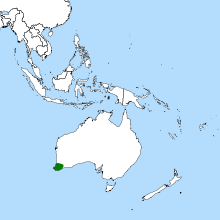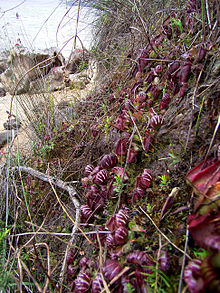
Pitcher plants are several different carnivorous plants that have modified leaves known as pitfall traps—a prey-trapping mechanism featuring a deep cavity filled with digestive liquid. The traps of what are considered to be "true" pitcher plants are formed by specialized leaves. The plants attract and drown their prey with nectar.

Oxalidales is an order of flowering plants, included within the rosid subgroup of eudicots. This group comprises six families that contain approximately 2000 species in 58 genera. They are trees, shrubs or woody vines which are found in the wet tropics, particularly on mountains, and warm temperate zones, especially in the southern hemisphere. Compound leaves are common in Oxalidales and the majority of the species in this order have five or six sepals and petals. The following families are typically placed here:
In biology, a monotypic taxon is a taxonomic group (taxon) that contains only one immediately subordinate taxon. A monotypic species is one that does not include subspecies or smaller, infraspecific taxa. In the case of genera, the term "unispecific" or "monospecific" is sometimes preferred. In botanical nomenclature, a monotypic genus is a genus in the special case where a genus and a single species are simultaneously described. In contrast, an oligotypic taxon contains more than one but only a very few subordinate taxa.
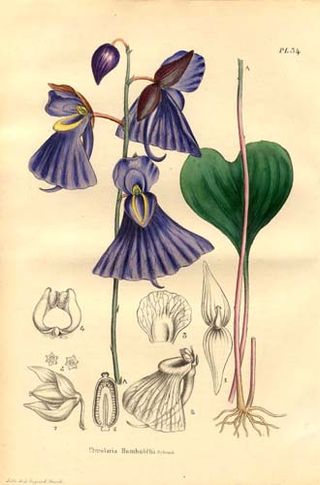
Lentibulariaceae is a family of carnivorous plants containing three genera: Genlisea, the corkscrew plants; Pinguicula, the butterworts; and Utricularia, the bladderworts.

Stylidium is a genus of dicotyledonous plants that belong to the family Stylidiaceae. The genus name Stylidium is derived from the Greek στύλος or stylos, which refers to the distinctive reproductive structure that its flowers possess. Pollination is achieved through the use of the sensitive "trigger", which comprises the male and female reproductive organs fused into a floral column that snaps forward quickly in response to touch, harmlessly covering the insect in pollen. Most of the approximately 300 species are only found in Australia, making it the fifth largest genus in that country. Triggerplants are considered to be protocarnivorous or carnivorous because the glandular trichomes that cover the scape and flower can trap, kill, and digest small insects with protease enzymes produced by the plant. Recent research has raised questions as to the status of protocarnivory within Stylidium.

Adenanthos is a genus of Australian native shrubs in the flowering plant family Proteaceae. Variable in habit and leaf shape, it is the only genus in the family where solitary flowers are the norm. It was discovered in 1791, and formally published by Jacques Labillardière in 1805. The type species is Adenanthos cuneatus, and 33 species are recognised. The genus is placed in subfamily Proteoideae, and is held to be most closely related to several South African genera.

Banksia ser. Dryandra is a series of 94 species of shrub to small tree in the plant genus Banksia. It was considered a separate genus named Dryandra until early 2007, when it was merged into Banksia on the basis of extensive molecular and morphological evidence that Banksia was paraphyletic with respect to Dryandra.

Banksia repens, the creeping banksia, is a species of shrub in the plant genus Banksia. It occurs on the south coast of Western Australia from D'Entrecasteaux National Park in the west to Mount Ragged in the east.

Archaeamphora longicervia is a fossil plant species, the only member of the hypothetical genus Archaeamphora. Fossil material assigned to this taxon originates from the Yixian Formation of northeastern China, dated to the Early Cretaceous.
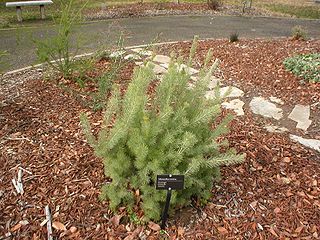
Adenanthos sericeus, commonly known as woolly bush, is a shrub native to the south coast of Western Australia. It has bright red but small and obscure flowers, and very soft, deeply divided, hairy leaves.

Utricularia dichotoma, commonly known as fairy aprons, is a variable, perennial species of terrestrial bladderwort. It is a widespread species with mauve or purple fan-shaped flowers on a slender stalk and usually grows in wet locations.
Amphibolis antarctica is a species of flowering plant in the family Cymodoceaceae. It is referred to by the common names wire weed or sea nymph, and is a seagrass found in coastal waters of southern and western Australia.

Carnivorous plants are plants that derive some or most of their nutrients from trapping and consuming animals or protozoans, typically insects and other arthropods, and occasionally small mammals and birds. They still generate all of their energy from photosynthesis. They have adapted to grow in waterlogged sunny places where the soil is thin or poor in nutrients, especially nitrogen, such as acidic bogs. They can be found on all continents except Antarctica, as well as many Pacific islands. In 1875, Charles Darwin published Insectivorous Plants, the first treatise to recognize the significance of carnivory in plants, describing years of painstaking research.

The flora of Western Australia comprises 10,551 published native vascular plant species and a further 1,131 unpublished species. They occur within 1,543 genera from 211 families; there are also 1,317 naturalised alien or invasive plant species more commonly known as weeds. There are an estimated 150,000 cryptogam species or nonvascular plants which include lichens, and fungi although only 1,786 species have been published, with 948 algae and 672 lichen the majority.

Adenanthos obovatus, commonly known as basket flower, or, jugflower, is a shrub of the plant family Proteaceae endemic to Southwest Australia. Described by French naturalist Jacques Labillardière in 1805, it had first been collected by Archibald Menzies in 1791. Within the genus Adenanthos, it lies in the section Eurylaema and is most closely related to A. barbiger. A. obovatus has hybridized with A. detmoldii to produce the hybrid A. × pamela. Several common names allude to the prominent red flowers of the species. It grows as a many-stemmed spreading bush up to 1 m (3.3 ft) high, and about 1.5 m (4.9 ft) across, with fine bright green foliage. Made up of single red flowers, the inflorescences appear from April to December, and peak in spring.
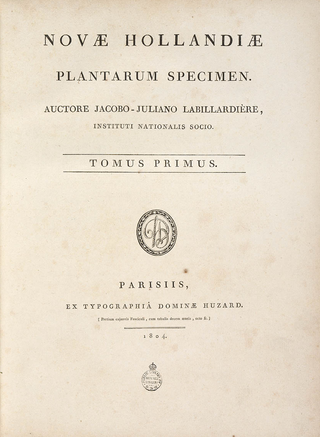
Novae Hollandiae Plantarum Specimen is a two-volume work describing the flora of Australia. Facsimiles of the originals can be found in the online Biodiversity Heritage Library (Vol.1) and Vol 2).
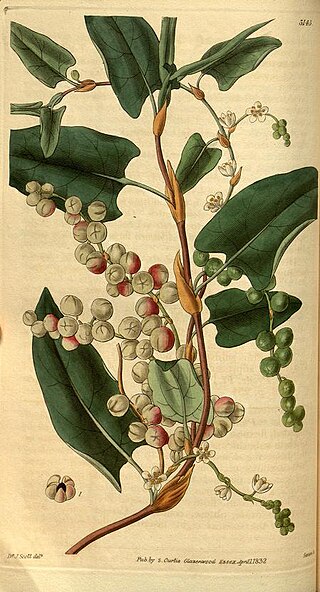
Muehlenbeckia adpressa, commonly known as climbing lignum, is a prostrate or climbing plant, native to Australia. It has thin red-brown stems up to 1 metre in length. The leaves are 1.5–6 centimetres (0.59–2.36 in) long and 1.5–3.5 centimetres (0.59–1.38 in) wide. It occurs in coastal areas of Western Australia, South Australia, Tasmania, Victoria and New South Wales.

Adenanthos cuneatus, also known as coastal jugflower, flame bush, bridle bush and sweat bush, is a shrub of the family Proteaceae, native to the south coast of Western Australia. The French naturalist Jacques Labillardière originally described it in 1805. Within the genus Adenanthos, it lies in the section Adenanthos and is most closely related to A. stictus. A. cuneatus has hybridized with four other species of Adenanthos. Growing to 2 m high and wide, it is erect to prostrate in habit, with wedge-shaped lobed leaves covered in fine silvery hair. The single red flowers are insignificant, and appear all year, though especially in late spring. The reddish new growth occurs over the summer.
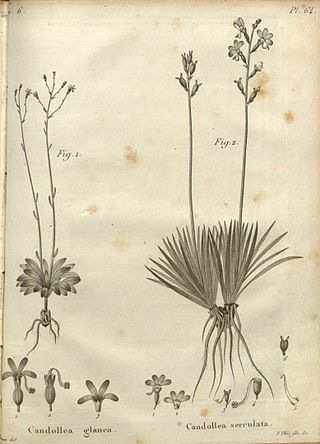
Stylidium glaucum, the grey triggerplant, is a herbaceous plant found along the southern coast of Southwest Australia, West of Albany. The plant attains a height between 0.15 and 0.65 metres. The leaves are lanceolate in form, becoming pointed at the base, and moderately acute at the tip. These are between 20 and 70 millimetres in length and 2 to 9 millimetres in width, are hairless, and have an entire margin. The trivial name of the species, glaucum, refers to the greyish colour of the leaves. The scape is hairless, supporting a racemose arrangement of white or pink flowers that appear from January to May.

The Australian pitcher plant, also known as Albany pitcher plant, is the only species of plant in the Cephalotaceae family and Oxalidales order. It can be found exclusively in moist conditions in a small region in southwest Australia and is considered to be a carnivorous plant. Similar to the not related Nepenthes, it catches its victims with pitfall traps.

